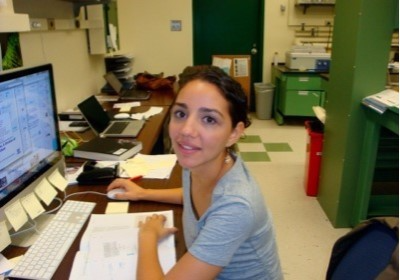CIE Researcher of Distinction, December 2014
Alexis Santana

Each month, the Center for Inclusive Education showcases the outstanding research being conducted by one of our talented scholars in our Research Café series. In addition, we recognize this scholar as a Researcher of Distinction and share the details of his/her journey to becoming an accomplished scholar. This month's Researcher of Distinction is Alexis Santana, PhD candidate in the Department of Molecular Genetics & Microbiology. Alexis presented her talk, ‘The Interplay of RTA and NF-kB Signaling During Gammaherpesvirus Infection’ on Wednesday, December 10, 2014.
Alexis's Path Into Research
Alexis Santana was born in New York and raised in the Bronx for 13 years. In 1999, her family moved further upstate where she attended Minisink Valley High School. When in high school, Alexis ran track and participated in the New Visions Program, a NYS BOCES publicly-funded initiative. The program provided in-depth study of professional career opportunities in medicine for high school students. While taking college courses for credit, Alexis would shadow medical professionals in different specialties throughout the school year. It was through this program that she was able to identify an interest in science and medicine.Alexis pursued her undergraduate degree at SUNY New Paltz with a major in Cell and Molecular Biology and a minor in Art History. She was heavily involved in the Collegiate Science and Technology Entry Program (C-STEP). Through this program, Alexis was a tutor and participated in two summer research opportunities. Initially, Alexis never considered pursuing a PhD. It was through her involvement in C-STEP that this pursuit became an option. Alexis’s mentor, Dr. Stacie Nunes helped her identify an interest in science research and was the one who introduced her to the NSF-Bridge to the Doctorate program. Dr. Nunes helped Alexis prepare her application and her acceptance made the option of having a PhD a reality.
Alexis's Current Research
Describe the work you will be presenting for your Research Café.
Herpesviruses support two modes of infection: Lytic replication and latency. Gammaherpesviruses (γHV) establish latency in B lymphocytes and their latent programs are associated with the development of lymphomas. Investigating the role of both virus and host determinants in promoting the establishment and reactivation from latency is an important area of investigation for the γHV. The human γHV, Epstein-Barr Virus (EBV) and Kaposi’s sarcoma-associated herpesvirus (KSHV), co-opt host NF-κB signaling pathways to promote latency establishment, virus gene regulation and cell survival. Disruption of the NF-κB signaling pathway poses a potential therapeutic target as it induces the apoptosis of EBV+ and KSHV+ lymphomas in culture and delays tumor progression of these cells in mice. Our laboratory made similar observations for murine γHV68 (MHV68) latently infected B cells. The purpose of my project is to define the importance of this virus-host interaction in promoting B cell latency during γHV infection.
Are there any other projects you are currently working on?
One understudied area of research in our field is the identification of binding sites for an MHV68 encoded transcription factor in the virus genome. This transcription factor is necessary for herpesvirus lytic replication. With this question in hand, I have generated tools necessary to identify changes in protein binding during reactivation from latency and for lytic replication in vivo by ChIP-seq. We hope our results will identify novel consensus binding sites that provide insight into how MHV68 genes are turned on during lytic replication.
What was the deciding factor for you to come to Stony Brook for your graduate studies?
One deciding factor was that Stony Brook has one of the best programs in Molecular Genetics and Microbiology. I can remember my interview day vividly. The faculty was welcoming and the students were genuinely happy with both their training experience and labs. In addition, the presence of the Center for Inclusive Education (CIE) reminded me of the undergraduate C-STEP community I had been involved with. Lastly, the NSF-Bridge to the Doctorate Fellowship was an added deciding factor.
What are your future goals?
My future goals are to write-up my first author publication and apply for graduation. After graduation, I plan to work in a postdoctoral position in academia.
What do you enjoy most about research?
The most intriguing aspect of working in science is the opportunity to contribute to a field of study by carrying out research experiments that both serve the community and feed my hunger for gaining new knowledge. I am fueled by the prospect of tackling a scientific question that remains unanswered.
